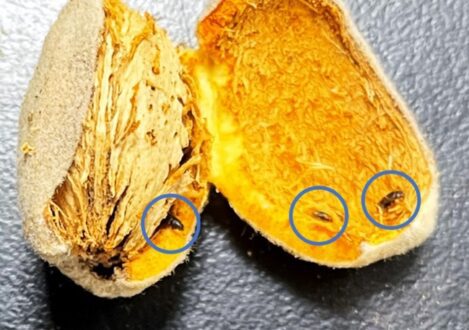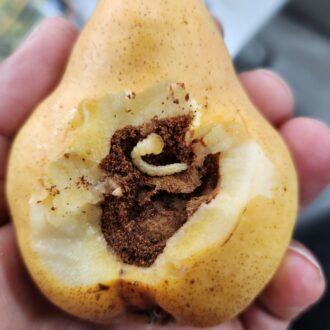Dec 11, 2023New, old pests found in California nut, pear orchards
Two different beetle pests found in California orchards this year have growers on alert and researchers looking to learn more as they try to develop treatments to control infestations.
One is the arrival of a new invasive beetle, the Carpophilus truncatus, which was found infesting almonds and pistachios in the San Joaquin Valley earlier this fall. The other is an existing native pest—a species of flatheaded borer that historically attacked only wood but was found feeding on pear fruit in Lake County.
University of California researchers who are studying the insects want to get the word out to growers so they can be on the lookout for the pests.
The carpophilus beetle is new to California and the U.S., but growers in Australia have been trying to manage infestations for nearly 10 years, said Jhalendra Rijal, UC integrated pest management advisor. The insect is concerning because the adults and larvae feed directly on the kernel, reducing quality and yield.

“They’re using that nutmeat as a food source,” Rijal said. “It’s a pretty serious issue in that regard.”
The presence of the beetles has been confirmed in Stanislaus, Merced, Madera and Kings counties. They were found in almond and pistachio orchards, but Rijal said the bugs have also been reported in walnut orchards in Italy and Argentina.
They’ve been difficult to identify, Rijal said, because they look like the closely related dried-fruit beetle, which attacks a wide variety of ripe, decomposing and dried fruits. Like the navel orangeworm, the carpophilus beetle overwinters in unharvested mummy nuts.
The adult beetles move into tree canopies during the summer, depositing eggs onto developing nuts. The larvae that emerge bore into the kernel, leaving a hole surrounded by a dusting of insect frass.
With the state’s increasing tree nut acres, Rijal said keeping up with winter orchard sanitation becomes “critically important” to control worm and beetle infestations.
The wet winter last season made orchard sanitation more difficult for growers, resulting in a buildup of pest populations. If their numbers are not reduced, the pests will become out of control, Rijal said.
“That’s why we say sanitation, sanitation, sanitation,” he said. “It was the motto when we only had navel orangeworm. But now a beetle also does the same thing.”
The source of the carpophilus beetle remains unclear. But considering infestations found last year in several California orchards, Rijal said he suspects the insect may already be widespread and has been in the state for at least several years and “just slipped through the cracks.”
Beetle switches from wood to fruit
Meanwhile, a different kind of beetle — the Pacific flatheaded borer — found attacking pear fruit in Lake County is “blowing entomologists’ minds,” said Clebson Gomes Goncalves, UC diversified farm advisor for Lake and Mendocino counties. That’s because the beetle is known as a wood-boring insect, with no previous record of it feeding on fruits.
“It’s confusing because they should be attacking the bark of the tree, not the fruit,” Goncalves said of the beetle.


Discovery of the beetle larvae on pears was made “kind of by accident” by an area pest control advisor who thought the damage was done by codling moth—until he cut open the fruit, Goncalves said. Entomologists from other states familiar with the borer were all surprised by the find, as “it’s a total change in behavior” for the insect, he said.
“Is this a one-off situation where three years of drought caused the bark beetle to change its normal reproductive habits?” asked Bob McClain, research director for the California Pear Advisory Board.
He noted the PCA who made the initial discovery identified four orchards where the insect was feeding on pear fruit. Because larvae were found in multiple orchards throughout the field, Goncalves said it does not appear to be “a mistake of just one female” laying eggs on the fruit rather than the wood.
Three of the orchards are organically farmed; the fourth is conventional. None of them applied the insecticide abamectin after petal fall for the pear psylla pest, and the PCA did not find beetle larvae in other conventional orchards he works with that did apply abamectin. This implies that orchards that did not use the insecticide are susceptible to the insect, McClain said.
Considered a secondary pest, the flatheaded borer can be found in established orchards, but the beetles usually don’t cause severe economic damage, so growers don’t typically treat their orchards for the insect, Goncalves said.
But Rijal said San Joaquin Valley walnut growers have seen increasing pressure of the Pacific flatheaded borer in their orchards since 2018, when they began reporting “high levels of damage on their branches.” Walnuts appear to be more susceptible than other tree crops.
The borer is native to the West and has always existed in the valley, Rijal said. Before 2018, it was an occasional pest found in orchards, especially young ones. But something has changed, he said, as the insect has become more aggressive and is now attacking older orchards too.
“That’s why I like to call it an old pest, a new problem,” Rijal said.
The flatheaded borer is now widespread in the valley, with growers becoming more aware of it and reporting infestations, he said. Some infestations are so severe that growers are forced to pull entire orchards.
Because the insect bores into wood, it is difficult to control, though Rijal said he’s testing different insecticides that might help. For Lake County pear growers, it’s unclear how they should treat infestations when the insect attacks the fruit.
“We’re first trying to figure out if this is going to happen next year,” Goncalves said.
The beetle larvae may not survive through the winter on the fruit, he said, as the fruit will rot, unlike wood, where the larvae can grow through the summer, go dormant in the winter, and then emerge as an adult in late spring. In pears, the insect creates a chamber in the fruit that becomes dry and firm.
McClain said the advisory board has solicited a research proposal from Goncalves and Cindy Kron, UC integrated pest management advisor for Napa, Sonoma, Mendocino and Lake counties, to do a survey of pear orchards in Lake County for recurrence of the borer in pear fruit.
Monitoring was hampered this year because the damaged fruit was discovered late in the season. Growers may be able to trap the adult beetle earlier in the season. “This would give growers and PCAs a heads-up to an infestation,” McClain said.
— Ching Lee, Ag Alert, California Farm Bureau Federation.














